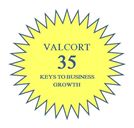Are you a victim of organizational drift?
Valcort 35 Keys to Business Growth. #17: Have a formal process in place that makes sure that your products and services, your sales approach, and your internal operations all line up with the needs of specific, well-defined customer groups.
Slipping on the fins and covering my face with the snorkel and mask, I jumped overboard.
The world beneath Baja Mexico’s Sea of Cortez was magical. Surrounded by thousands of silvery fish I was transported 15 feet deep into the center of a fish cloud. I returned to the surface for seconds to gasp a breath and plunged down again. I drifted, suspended with the current and fish, and once again quickly surfaced to fill my lungs, plunged and drifted again and again.
It was amazing. And dangerous.
Surrounded by a community of friendly fish that were all headed in the same direction, I hadn’t realized how far and how fast the current had taken me, and how lost I really was.
I had been pushed hundreds of yards from the boat and safety. I had lost sight of where I was and where I was going. Now slightly panicked, I found getting back to the boat took more time and more energy than I had imagined.
We all drift. Organizations drift. People drift. Sales teams drift. And for good reason.
A customer crisis intrudes. A direct report texts you with a production problem. A new equipment purchase requires consideration or a great partnership opportunity shows up.
We all have a tendency to get caught in the moment. And if you’re not organizationally self-aware of where you are today, where your customers are going, and what you’re doing about it, getting caught in the moment leads to drifting, and then you’re in trouble.
The real danger is in the invisible currents. Whether you know it or not, your market is shifting– today, right now. Your customers’ needs are changing, and new technology is rapidly disrupting your relationships. So day by day, week by week and month by month, you become disoriented managing the business as the current silently sweeps you away.
Blockbuster lost sight of their customers and as their customers’ purchase patterns shifted from physical video rentals to live streaming, Blockbuster drifted.
Kodak, once an innovative technology leader, lost sight of a changing digital market. Their leaders silently drifted into complacency and their customers went elsewhere.
Bookstore giant Borders believed their advancements in book inventory control and widespread bricks and mortar outlets would keep them safe and relevant to their customers. They neglected the innovations in their market, became irrelevant and drifted into oblivion.
What will keep you from drifting?
When you’re drifting, you’re making assumptions. And one day, you come up for air and realize your assumptions are wrong and you’re more focused internally than externally. You’re at risk, and you can see that getting correctly aligned to the market is going to take more energy and more resources than you imagined.
To prevent market drift, you need two things: First, you need a clear understanding and alignment of your organization to your vision. Second, you must maintain a constant awareness of how your market is changing and where opportunity lies.
Many organizations think their sales team can manage this market assessment process. We have never seen this work. Most sales teams are swimming deep in the current, surrounded by the customers within their reach. They are biased and lost in the current themselves. You need an independent third party to bring objectivity and credibility to the process.
Over the thousands of hours working with organizations from F200 and to small cap start-ups, we have seen our clients’ employees miraculously align and focus on solving customer problems when they have clarity on these two issues. As a result, a previously reactive, transactional focus will shift, almost automatically, and employees take initiative and create solutions that build customer relationships. And with this focus comes increased customer value, trust, loyalty, retention, and advocacy.
A best-in-class VALCORT organization regularly and systematically probes its market for changes that create new opportunities. It identifies new currents, noting speed and direction and then flexibly adapts and strengthens, learns, engages and captures the best opportunity.
Don’t be taken captive by the demands of the moment and invisible market currents.
Having a formal, periodic process to understand your customers will light up your employees and will prove a valuable tool to drive change, alignment and growth.
____________________________________
 The Valcort 35 Keys to Business Growth
The Valcort 35 Keys to Business Growth
Over many years and hundreds of client relationships and strategic marketing opportunities, we have established the Valcort 35 Keys to Business Growth, best practices that build trust, align values with products and practices, and create organic growth. We are exploring these 35 practices, one at a time, on these pages. Find them all, as they’re introduced, here.
Tags: organizational drift, organizational drifting, Valcort, Valcort 35 Keys to Business Growth, vision





